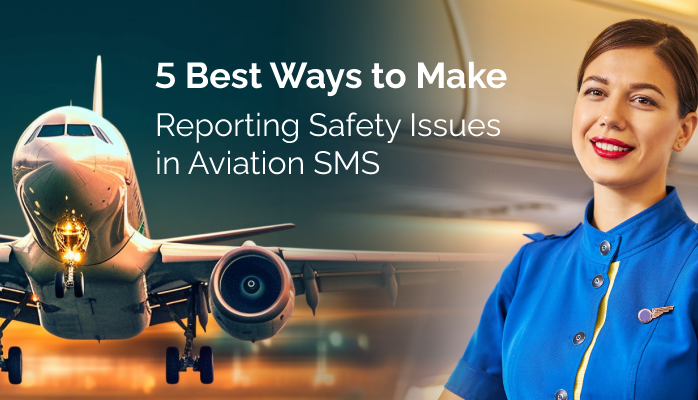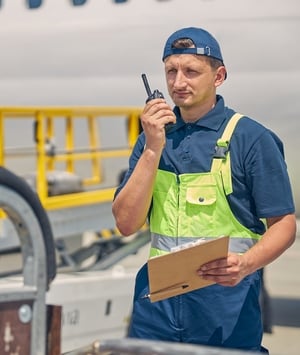Building Hazard Reporting Culture through Convenience

If you want to improve your aviation SMS program’s hazard reporting culture, the first thing you should do is to see if you can make hazard reporting easier.
“Easier” is a tricky word.
Are manual hazard reporting forms easy? The long answer begins with: it depends on the situation. The short answer is: sometimes yes, sometimes no.
It’s the “sometimes no” that you should care about. In your SMS program, in which situation is it not convenient to report issues? To improve your hazard reporting process, seek out situations when reporting is not easy, and find a way to make reporting convenient in that situation.
Be careful of the word convenient. Convenient does not mean “quick” or “when the employee feels like it.” The goals of making hazard reporting convenient are:
- Reports can be submitted in conjunction with employees’ current activity (as opposed to 2 days later);
- Easy access to submitting reports (anytime, anywhere); and
- Involving as little trouble as possible, such as being able to report via a cell phone right after the incident, as opposed to going to an office and filling out a report much later.
The way to make hazard reporting convenient is to offer many avenues of hazard reporting. Here are 5 of the best way to make hazard reporting more convenient in aviation SMS, and build your aviation safety culture.
1 – Custom Forms in Standard Hazard Reporting Process
Including multiple custom reporting forms offers incentive for employees to submit safety issues. Custom forms provide:
- Guidance by offering specific form fields or multiple choice;
- Expediency by only asking for most pertinent information; and
- Organization by only collecting relevant information that is pre-organized into form fields.
Some example hazard reporting forms you should consider using in your aviation SMS are:
- Maintenance reporting form;
- Air traffic control reporting form;
- Fatigue reporting form;
- Bird strike reporting form;
- Cabin safety reporting form;
- Flight safety reporting form;
- Captain’s trip reporting form;
- Security officer reporting form; and
- Passenger/client incident reporting form.
Each of the above forms will have different usefulness to your company depending on your type of operation.
Related Articles on Aviation Hazard Reporting
- What Good Hazard Reporting Process Look Like in Mature Aviation SMS
- Essential KPIs for Poor Hazard Reporting Cultures in Aviation SMS - with Free KPI Resources
- Safety Chart: How to Maintain Monthly Aviation SMS Hazard Reporting Goals
2 – While Performing Other Activities (Audit, Change Management, etc.)

Integrating hazard reporting with other aspects of your SMS is a powerful way to generate timely hazard reports. For manual reporting systems, this is difficult to do. With aviation SMS software, this is much easier.
Integration looks like:
- While doing one activity, such as auditing, you can submit safety issues directly as they arise; versus
- After doing one activity, such as auditing, you need to go through your audit and submit each safety issue.
Other activities where integration becomes very helpful are:
- Management of change;
- Risk control review;
- Gap analysis;
- Implementation management;
- Safety inspections; and
- Flight risk activities.
3 – Offline Reporting When Away from Internet
Being able to submit reports offline is an extremely beneficial way to stimulate timely hazard reports. When employees have to submit a safety report long after the incident happens, they may either wait for several delays before they submit (a common problem) or not submit a report at all (another common problem).
Offline reporting means offering employees a way to fill out their reports when:
- They are away from the internet (aviation SMS software); or
- They are away from the report drop-off location (manual reporting systems).
In case #1, employees would be able to fill out the report offline, and then that report is automatically submitted when the device connects to the internet.
In case #2, employees would always have a reporting form on hand, such as in hard copy or an Excel template, where they could fill it out and turn it in later.
Either way, offline reporting ensures that hazard reporting is always within reach of employees.
4 – Public Issue Reporting
Public issue reporting allows people to submit issues from a public location, such as your company website. In such a case, this allows not only employees to submit issues from the comfort of their desk or home, but it involves the public in your reporting process (thus adding an extra layer of protection).
Public reporting is simply a link on your website with a simple reporting form where basic information is gathered.
Related Hazard Reporting Culture Articles
- How to Write Non-Punitive Reporting Policy for Aviation SMS Programs - Free Templates
- How to Bring Your Aviation Safety Reporting System to Compliance?
- How Spreadsheets Not EASA Compliant Aviation Safety Reporting Database
5 – Email Issue Reporting
Email issue reporting is very similar to public issue reporting. With email reporting, you would have a default email address set up that the public/employees can email. Each email would generate a safety issue (or other types of relevant concern).
Why have public and email reporting? The point is to offer multiple avenues of submitting for convenience. In some situations, or with some people, using a public reporting form is the most convenient. In other situations, or with other people, email may be the most comfortable format for reporting issues.
Final Thought – Submit Issue from Mobile Device
Finally, one more method to consider that can easily be integrated with any of the above ways for conveniently reporting safety issues is allowing employees to submit from their cell phones, iPad, etc. This involves:
- Ensuring that public reporting form is optimized for mobile devices (contact your webmaster);
- Ensure that offline reporting can be accessed via a mobile device; and
- Ensure that custom reports are mobile-friendly.
For more information about hazard reporting and hazard identification, you may find the following valuable:
Last updated September 2023.


